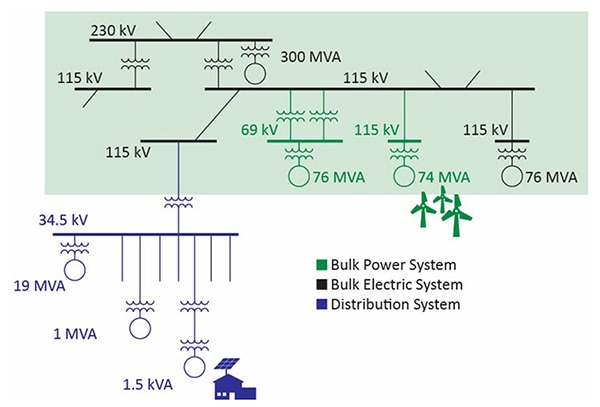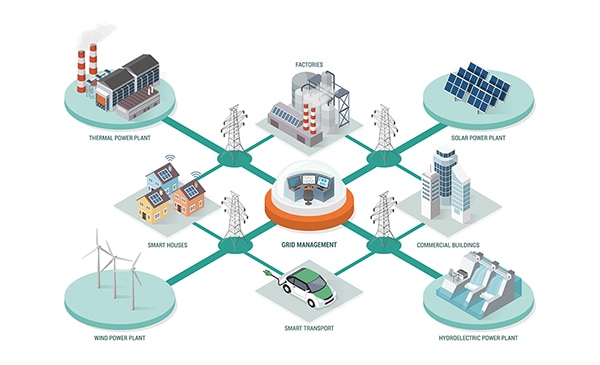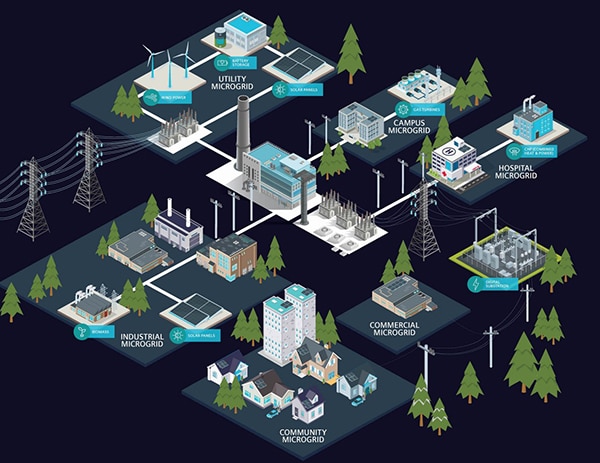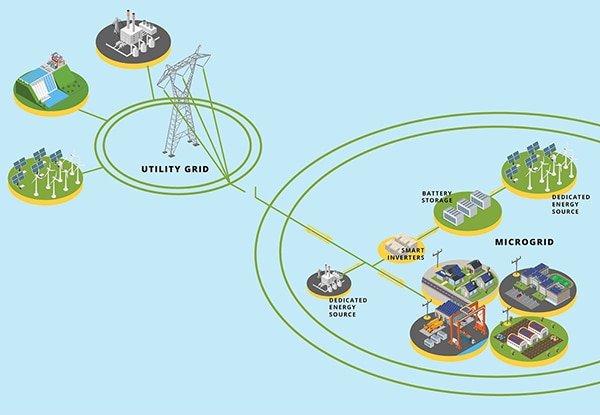Using Electrification and Automation to Create More Efficient and Sustainable Power Grids – Part One of Two
Contributed By DigiKey's North American Editors
2023-09-12
Replacing traditional power grid energy sources with sustainable, green ones is called electrification. In this article, Part 1 of 2, some of the challenges associated with electrification are discussed along with how automation can aid in its efficiency and sustainability. Part 2 of this series will discuss leadership in energy and environmental design (LEED) and zero energy building (ZEB) certifications and how they can reduce carbon emissions and improve sustainability.
Electrification is the replacement of systems that use fossil fuels like oil, coal, and natural gas for electricity generation with photovoltaics (PVs) and other green technologies and replacing internal combustion engine (ICE) vehicles with electric vehicles (EVs). Electrified systems, plus the use of automation that ties them all together and supports smart grids and microgrids, are important factors moving society toward a more sustainable and greener future.
Today’s electric grid was not designed to charge large numbers of EVs, and smart grids and microgrids are expected to be critical technologies needed to support the widespread replacement of ICE vehicles with EVs. In California, the governor recently issued an Executive Order requiring that by 2035 all new car and passenger light truck sales be zero-emission vehicles (EVs). Developers of smart grids and microgrids must meet a daunting array of international standards to tackle these sorts of mandates. For example, the IEEE has over 100 standards approved or in development relevant to smart grids, including the more than 20 IEEE standards named in the National Institute of Science and Technology (NIST) Framework and Roadmap for Smart Grid Interoperability. In addition to IEEE standards, microgrids are governed by the IEC 62898 microgrid series and other standards.
This article is the first of two parts. It looks at challenges related to implementing electrification, integrating distributed energy resources (DERs), the similarities and differences between smart grids and microgrids, and how automation enhances their efficiency and sustainability, including supporting the universal adoption of EVs. It begins by digging into what DERs are and where they fit in and closes by looking at how the emergence of utility microgrids is blurring the distinction between microgrids and smart grids. Whatever the implementation, DigiKey supplies a wide array of industrial automation products that support electrification and DER integration. The second article examines how electrification and automation can be used in green buildings to achieve Leadership in Energy and Environmental Design (LEED) and Zero Energy Building (ZEB) certifications.
What’s a DER?
The North American Electric Reliability Corporation (NERC) definition is: “a Distributed Energy Resource (DER) is any resource on the distribution system that produces electricity and is not otherwise included in the formal NERC definition of the Bulk Electric System.”
The term distribution system in North America refers to electric lines carrying 34.5 kilovolts (kV) or less that typically run from substations to end users. The bulk power system (BPS) includes the lines coming into the substation that often carry 100+ kV over long distances, connecting large-scale bulk electricity generation facilities with interconnection resources and substations (Figure 1).
 Figure 1: DERs exist in the distribution system (blue); other renewable energy resources are in the bulk power system (green). (Image source: NERC)
Figure 1: DERs exist in the distribution system (blue); other renewable energy resources are in the bulk power system (green). (Image source: NERC)
DERs are any non-bulk system resource, including generation units like wind turbines and photovoltaic installations, energy storage units, most battery energy storage systems (BESS), EV battery chargers — also called electric vehicle service equipment (EVSE)— and microgrids. DERs exist behind the utility meter as well as directly on the distribution system. Behind the meter, DER sources include photovoltaic arrays, BESS, grid-connected EVs, and standby backup power sources like large diesel generator installations at data centers and other locations. A microgrid is a particular type of DER.
Smart grids, microgrids, and electrification
A microgrid is a DER, but not all DERs are microgrids. From the perspective of the BPS, the terms microgrid and DER refer to types of power generation or storage resources. The term smart grid refers to the communication and control technologies used by the BPS to ensure resilient and efficient operation. Another differentiating factor is that microgrids include generating and storage resources plus loads. A smart grid is comprised primarily of generation resources, with some storage but no loads. The smart grid can communicate with loads, but they are separate from the grid.
Electrification affects microgrids, the BPS, and smart grids in different ways. In the BPS, electrification is being added to an existing grid and, if not properly managed, can have unintended negative operational consequences. That’s where smart grid technology comes in.
Two-way communications and control are the primary differentiator of smart grids. Those control systems include sensors to monitor the stability of the grid and advanced meters to monitor electricity demand. They also use a variety of controllable power switching and power quality devices to manage electricity flows. The sensors are critical to enable greater penetration of renewable energy (RE) sources and electrification into the BPS and ensure grid stability. In addition, the sensors and control elements support faster and more effective responses to power disturbances and enable balancing and securing the grid, especially during peak demand periods and with variable RE availability. Smart grid technologies also support the coordination and integration of microgrids with the distribution system and BPS.
Conversely, a microgrid is designed to accommodate electrification technologies like RE sources, BESS, and EVs. Microgrids and smart grids require automated controls, including a distributed energy resource management (DERM) system.
DERMs are a must
DERMs and automation are defined and implemented differently in smart grids and microgrids. Smart grids include diverse generation sources and electricity users spread over a wide area with a centralized control center for grid management (Figure 2). Grid management is the key concept for smart grid control in the BPS. Existing BPSs were designed and built before there was a need to support electrification, and they can experience unreliable operation as dispatchable (controllable) fossil-fuel-powered generation is increasingly replaced by unpredictable (and therefore less controllable) RE sources. In addition, charging large numbers of EVs will be mostly non-dispatchable and not directly controllable by the utility. The centralized, automated control enabled by smart grid technology is needed to compensate for the fact that the RE sources used for electrification and EV charging are not as predictable as conventional utility grid elements.
 Figure 2: A smart grid relies on automated controllers and DERMs for real-time grid management. (Image source: ETAP)
Figure 2: A smart grid relies on automated controllers and DERMs for real-time grid management. (Image source: ETAP)
Smart grid and microgrid controllers need information from various sensors to monitor connected resources in real time. With the advent of EVs and EVSE, the controllers are also used to help manage power demands of charging, and they can use vehicle-to-grid (V2G) communication to coordinate the connection of EVs to the grid or a microgrid to provide incremental energy storage capacity.
In addition to monitoring the status of connected resources, controllers for grid-connected microgrids must also monitor the status of the local utility grid. Switchgear is an essential component of smart grids and microgrids and must respond in milliseconds to ensure robust operation. Switchgear sizes vary from a few kilowatts (kW) for small microgrids to multiple Megawatts (MW) for large microgrids and the utility grid. The switchgear and controller can be in the same cabinet for small microgrids, reducing costs and speeding installation. Smart grid and microgrid DERMs include intelligent metering of energy production and energy consumption that is used by cloud-based analytics to maximize the economic benefits of DERs and support high levels of resilience. The exact architectures of DERMs can vary for different varieties of microgrids.
Microgrid varieties
Microgrids can be classified by their applications and architecture. The three microgrid architectures are remote, networked, and grid-connected. Remote microgrids are in places like islands or remote mining and agricultural operations. They are also called off-grid microgrids and are physically separated from any utility BPS. They must be completely self-sufficient.
Networked or nested microgrids are networks of several individual DERs or microgrids connected to a common utility distribution system. They are usually controlled by a centralized supervisory system that balances the needs of the microgrid operation with support for the wider utility grid. The controller often assigns a hierarchy of importance to the microgrids and DERs to ensure that the most critical elements are protected. Applications for networked microgrids include community microgrids, smart cities, and the emerging category of utility microgrids.
Networked microgrids are a subcategory of grid-connected microgrids. All grid-connected microgrids are physically connected to the distribution grid, and they have a switching device at the point of common coupling (PCC) where the connection to the distribution grid occurs. During normal operation, a grid-connected microgrid is connected to the distribution grid. It can provide services to the grid, such as frequency and voltage regulation, real and reactive power support, and demand response to mitigate capacity imitations.
The microgrid is not connected to the utility distribution grid in an islanded operation. Islanding can occur because of a disruption in the distribution grid or for other needs like maintenance. When transiting from islanded to grid-connected operation, these microgrids need to sense the frequency of the distribution and synchronize operation before reconnecting.
There are numerous microgrid applications, including campuses, hospitals and medical centers, commercial installations, communities, and industrial facilities. The newest application category is utility microgrids (Figure 3).
 Figure 3: Microgrids are often categorized by their application. (Image source: Siemens)
Figure 3: Microgrids are often categorized by their application. (Image source: Siemens)
Blurring the line
Utility microgrids that blur the line between smart grids and microgrids are being deployed. In the process, the definition of a DER changes from a distributed energy resource to a dedicated energy resource. Utility microgrids are designed to reduce power outages due to extreme weather events, wildfires, and other unforeseen challenges. With existing grid architectures, large sections of the grid are de-energized for safety during extreme events.
An important and unfortunate impact of those unscheduled and extensive power outages is to discourage the use of EVs. Utility microgrids are seen as a key to widespread EV adoption. Utility microgrids are being proposed and deployed across the U.S. For example, Southern California Edison (SCE) has proposed the development of Public Safety Power Shutoff Microgrids to help maintain electricity availability as widely as possible during wildfires. Other utilities refer to the new grid architecture as community microgrids (Figure 4).
 Figure 4: Utility microgrids can include a wide range of assets spread over relatively wide geographic areas and blur the line between traditional microgrids and smart grids. (Image source: Edison International)
Figure 4: Utility microgrids can include a wide range of assets spread over relatively wide geographic areas and blur the line between traditional microgrids and smart grids. (Image source: Edison International)
The islanding capability of utility microgrids is key to improving electricity availability on a more granular level than is currently possible. It’s expected to be deployed in a wide range of microgrid sizes, from complete residential communities to public places, including schools and other strategic locations like fire stations, medical centers, and evacuation centers. EVSE installations are a crucial part of the designs of most of these community microgrids. As envisioned, the EVSE will support the grid connection of EVs as additional sources of backup power as well as for EV charging.
Conclusion
Electrification is necessary to ensure more sustainable power grids and drive reductions in CO2 emissions. Many electrification technologies like PV energy and EVs are not as predictable as the traditional resources they are replacing. That means electrification must be supported with advanced sensor networks and automated control systems in smart grids and microgrids.

Disclaimer: The opinions, beliefs, and viewpoints expressed by the various authors and/or forum participants on this website do not necessarily reflect the opinions, beliefs, and viewpoints of DigiKey or official policies of DigiKey.







